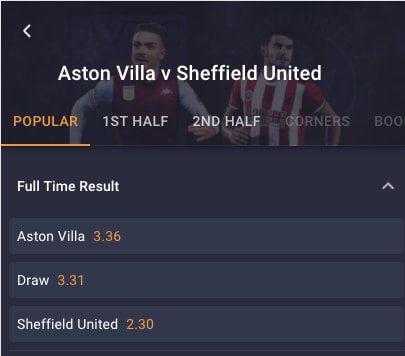That’s a great question. It’s the kind of thing you may be vaguely aware of but might struggle to explain to a friend. Margin in betting is essentially the price you pay to a bookmaker to take the risk of placing your bet. Think of it as the price you pay to play.
Obviously, the more you pay, the less you ultimately win in the end. A bookmaker offering a zero margin bet essentially lets you place that bet for free. At zero margin – given a large sample size and fair results – you wouldn’t expect to win, or lose, any of your bankroll.
Contents
The coin toss example
Let’s take a simple coin toss to illustrate. There are two possible outcomes: Heads or tails. That’s a 50/50 outcome, or an even-chance bet on either side.
In a fair game, the odds on that would be written in fractions as 1/1; in decimals, as 2.00.
The probability of an outcome (p=1) refers to a singular event. On this one coin toss, the probability of it being heads or tails is equal: so p=0.5 on both sides.
If you were to place this bet with a friend, neither of you would have an edge. For every $100 bet, you would stand to win $100 in return – and importantly, over time, say a sample size of 1000 coin tosses, you would expect to break even.
But bear in mind that a bookmaker is trying to trade a balanced market with the same liabilities on each possible outcome – and the margin allows for odds changes to encourage betting on less popular outcomes to achieve a balanced book.
Still running with the coin toss example, fair game (zero margin) odds would be 2.00, but a bookmaker would more likely offer, say 1.90 – meaning that if $100 is bet on heads and $100 on tails, there is a guaranteed profit of $10 ($100 made on the losing selection, less $90 paid to the winning selection).
That $10 is the bookmaker’s margin. On a zero-margin bet, you would win your full $100 and the bookmaker would take nothing.
Another way to write this is:
1.90 / 1.90 = 52.63% + 52.63% = 105.26%, whereas 2.00 / 2.00 = 50% + 50% = 100%
And that’s what you need to do to calculate margin….
How to calculate margin
However, in the betting world very few outcomes are as binary as a coin toss. For example even a full-time result 1×2 win/loss bet on a soccer match has to account for the possibility of a draw.
The remarkable amount of information that can be taken into account when looking at two soccer teams going head to head will inform the odds. For example, to name just a few: track records against each other; which team is playing home or away; each teams’ home and away record; who might be injured, or out of form, or just coming back from injury. This is why bookmakers handicap results and this all goes towards forming the odds that are finally offered.
Remember, the higher the margin, the higher the price you pay to play; the lower the margin, the less you pay to play, and therefore, ultimately more of your bankroll stays in your pocket.
Here’s an example of what Cloudbet odds on the opening game of the EPL restart may look like. As just explained above, because a bookmaker wants to balance its book, it’s likely that odds will change closer to kick-off. These numbers are purely indicative for the purpose of this exercise.
The main line Full Time Result odds are:
Aston Villa: 3.36
Draw: 3.31
Sheffield Utd: 2.30
If we take 100 – the breakeven level – and divide it by each set of odds, we get:
100/3.36 = 29.76
100/3.31 = 30.21
100/2.30 = 43.47
By adding these together, the sum gives us the total probability accounted for:
29.76 + 30.21 + 43.47 = 103.44
Above and beyond the 100, the margin on this bet is 3.44%.
Now let’s take a look at what zero margin looks like.
Here’s how Cloudbet might offer the game during its promotional window.
Aston Villa: 3.49
Draw: 3.42
Sheffield Utd: 2.36
So by using the same maths:
100/3.49 = 28.65
100/2.36 = 42.37
100/3.42 = 29.23
Therefore: 28.65 + 42.37 + 29.23 = 100.25.
The Roulette wheel and the house edge
Everyone knows the house never loses, right? But that only rings true over time. Why? Because the house will generally always have an edge in the long run.
Roulette offers a simple way to illustrate this. If you’ve ever bet on black, and seen black come up, you know that that pays out 100% of your stake – a $1000 bet on black pays $1000 – so the odds are offered at 50/50.
But don’t forget about the 0 – the one little green square that reduces the probability of winning a straight red/black bet by 1/37, or 2.7%. That’s the house edge.
By offering zero margin bets, Cloudbet is essentially removing the house edge that it would ordinarily have – so you can think of it as playing roulette on a wheel without the zero.
Why margin matters
If you want to protect your bankroll over an extended period of time playing your sportsbook, then margin matters. Remember, you’re paying to play… so why would you go to one store and pay $5.00 for milk when you could go to another right next door and pay $2.00?
The fact of the matter is that the range of margins on offer across a variety of bookmakers is likely to surprise, if not shock you.
Cloudbet has a history of providing best odds available across its sportsbook and esports markets, with margins typically of 2%-3%. Others sports books could be taking 7% or 8%, or even more.
Put like that, it seems like a no-brainer, right?
Here’s another one: Sign up today to start enjoying Cloudbet’s best odds and competitive market prices, and start your adventure in the crypto-verse!





